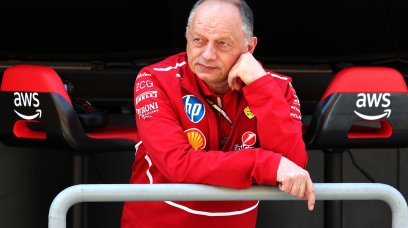F1 Chief Technical Officer Pat Symonds says he was surprised by Mercedes' dramatic new aerodynamic package, which has its roots in aerospace technology. The Silver Arrows set tongues wagging throughout the paddock with a new 'sidepod-less' version of the W13 for this week's pre-season test in Bahrain, featuring much slimmer sidepods than those seen on the car during last month's test in Barcelona. Narrow cooling inlets replace the larger, square intakes seen throughout the Barcelona test, with the side mirrors and some additional fins now mounted to 'wings' above where the bulk of the sidepods would normally sit. This prompted Symonds to acknowledge that Mercedes' design philosophy was unexpected.
Mercedes take a "very novel approach" to new F1 rules
"This is a very novel approach," Symonds told F1 TV of the new Mercedes package. "I have to say it's not one that I'd expected to see. I'm still really impressed at how they're getting the air through to cool the car, but they obviously are. "I think it will have got their rivals going back to the rulebook with their red pencil and seeing just what they've done." Red Bull Team Principal Christian Horner acknowledged on Friday that his team had concluded Mercedes' sidepods were legal , after initially taking some time to understand and digest the concept.
Symonds admitted that when his team of engineers drew up F1's new aero rules for 2022, they had anticipated a requirement for larger radiator inlets. "I guess it was just a little bit more radical than we thought," said Symonds. "As we developed the aerodynamics of this set of regulations, obviously, we looked at lots of things, not just downforce producing, but we had to look at brake cooling, had to look at tyre heating, and particularly, we had to look at engine cooling. "We were using a bigger inlet than that [on the W13] to get the cooling. "I think, on the Mercedes, they have a few little tricks in there that help them in this respect, and that's why they can really shrink wrap this car a little bit more than most of the others can." Symonds' thoughts echo those of F1 Managing Director Ross Brawn, who told F1 TV yesterday that he had not anticipated such a radical approach to the new regulations.
Further discussing the W13, Symonds added that Mercedes' unique cooling system had been developed using technology from the aerospace industry. "The intercooler, I think, comes from Reaction Engines in Oxfordshire, the people who are doing this air-breathing rocket motor, and the spin-off from that has been this really extremely efficient heat exchanger technology," said Symonds. "I think that's part of the reason why they've been able to produce the car the way they have." Symonds also explained that teams had found it difficult to reduce the size of the sidepods, owing to all the ancillaries packaged into that area of the bodywork. "I think one of the trends we're seeing, and it's not particular to these new regulations, but we're seeing that it's very, very difficult to start to package everything into the sidepods," he continued. "People think what's in the sidepods, surely it's only the radiators, the heat exchangers? "But of course, there's a lot more, there's a lot of electronics in there. I think some people are moving the electronics into that keel area."
Most read







